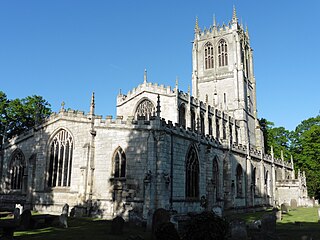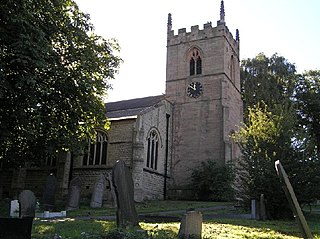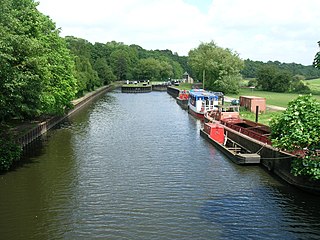
Conisbrough is a town within the City of Doncaster, in South Yorkshire, England. It is roughly midway between Doncaster and Rotherham, and is built alongside the River Don at 53°29′N1°14′W. It has a ward population of 14,333.

Doncaster is a city in South Yorkshire, England. Named after the River Don, it is the administrative centre of the City of Doncaster metropolitan borough, and is the second largest settlement in South Yorkshire after Sheffield. Noted for its racing and railway history, it is situated in the Don Valley on the western edge of the Humberhead Levels and east of the Pennines. It had a population of 87,455 at the 2021 census, whilst its built-up area had a population of 160,220, and the wider metropolitan borough had a population of 308,100.

Tickhill is a market town and civil parish in the City of Doncaster, South Yorkshire, England, close to the border with Nottinghamshire. At the 2001 census it had a population of 5,301, reducing to 5,228 at the 2011 Census.

Balby is a suburb of Doncaster in South Yorkshire, England, located south-west of the city centre. Historically part of the West Riding of Yorkshire, Balby is within the Doncaster Central constituency and contains the electoral wards Balby South and Hexthorpe and Balby North.

Killamarsh is a village and civil parish in North East Derbyshire, England, bordering Rotherham to the north and Sheffield to the north-west. It lies close to Derbyshire’s border with South Yorkshire.

Ingleton is a village and civil parish in North Yorkshire, England. The village is 17 miles (27 km) from Kendal and 17 miles (27 km) from Lancaster on the western side of the Pennines. It is 9 miles (14 km) from Settle. The River Doe and the River Twiss meet to form the source of the River Greta, a tributary of the River Lune. The village is on the A65 road and at the head of the A687. The B6255 takes the south bank of the River Doe to Ribblehead and Hawes. All that remains of the railway in the village is the landmark Ingleton Viaduct. Arthur Conan Doyle was a regular visitor to the area and was married locally, as his mother lived at Masongill from 1882 to 1917. It has been claimed that there is evidence that the inspiration for the name Sherlock Holmes came from here.
Sprotbrough and Cusworth is a civil parish in the City of Doncaster in South Yorkshire, England, with most of its settlements on the western edge of the Doncaster built-up area. It lies between 1 mile (1.6 km) and 4 miles (6.4 km) to the west of Doncaster and is split by the A1(M) motorway. It had a population of 12,166 in 2001 and 12,134 at the 2011 Census. The parish covers some of Doncaster's outlying western suburbs and commuter belt including the villages of Sprotbrough, Cusworth, and a small part of Scawsby, in addition to several rural hamlets and farmsteads.
Middleton Tyas is a village and civil parish in North Yorkshire, England. It is located near Scotch Corner.

Edlington is a town and civil parish in the City of Doncaster, South Yorkshire, England, lying to the south west of Doncaster and Warmsworth. It has a population of 8,276. The original parish town of Edlington is now known as Old Edlington; adjacent, and to the north, is New Edlington. It is often referred to by locals as 'Edlo'. Since 1974 Edlington has been part of the Metropolitan Borough of Doncaster in the metropolitan county of South Yorkshire. It had, since 1894, formed part of Doncaster Rural District in the West Riding of Yorkshire.

Stutton is a small village in the Selby District of North Yorkshire, England, a mile south-west of Tadcaster.

Hexthorpe is a suburb of Doncaster, South Yorkshire, England. Historically part of the West Riding of Yorkshire, the area's shape resembles a rhombus, with borders with Balby and Doncaster city centre, separated by railway lines and the river separating the area from the villages of Sprotbrough and Newton. The Hexthorpe House was a well known pub in the area. Following a fire, the pub remained derelict for a few months and the remains were demolished in 2009. The old pub sign was saved and has now been erected in Hexthorpe Flatts Park.

Levitt Hagg is an abandoned hamlet in South Yorkshire, located approximately two miles southwest of Doncaster and near Conisbrough Castle. Limestone began to be quarried at the site in ancient times. Levitt Hagg was also the site, along with nearby environs in the Don Gorge, of ancient woodlands rich in yew trees. The old settlement of Levitt Hagg was removed in the 1950s.

Kirk Bramwith is a village and civil parish in the Metropolitan Borough of Doncaster in South Yorkshire, England. It had a population of 200 in 2001, increasing to 320 at the 2011 Census. The village centre is located on a narrow strip of land, sandwiched between the River Don Navigation to the south east and the New Junction Canal to the north west. It is low-lying, with most of it close to the 16-foot (5 m) contour, and is almost surrounded by drainage ditches.

Loversall is a village and civil parish in the City of Doncaster in South Yorkshire, England. It has a population of 128, increasing to 156 at the 2011 Census.

Sprotbrough is a village in the City of Doncaster in South Yorkshire, England, with a population of 7,548 at the 2021 census. The village is transected by the A1(M) motorway and is situated at the top of the Don Gorge, some 3 miles (4.8 km) west of Doncaster city centre. With Cusworth to the north, it forms the civil parish of Sprotbrough and Cusworth, which had a population of 12,134 in 2011.

Hensall is a village and civil parish in the English county of North Yorkshire.

The Don Gorge is the valley of the River Don to the west of Doncaster, south of the village of Sprotbrough. The gorge is known as a 'green corridor'.
Balby South is a ward in the metropolitan borough of Doncaster, South Yorkshire, England. The ward contains three listed buildings that are recorded in the National Heritage List for England. All the listed buildings are designated at Grade II, the lowest of the three grades, which is applied to "buildings of national importance and special interest". The ward contains part of the suburb of Balby and part of the village of Warmsworth. The listed buildings in the ward consist of a church, and a large house, later a hospital and then offices, and associated structures.
Warmsworth is a civil parish in the metropolitan borough of Doncaster, South Yorkshire, England. The parish contains eight listed buildings that are recorded in the National Heritage List for England. Of these, one is listed at Grade II*, the middle of the three grades, and the others are at Grade II, the lowest grade. The parish contains the village of Warmsworth and the surrounding countryside. The most important building in the parish is Warmsworth Hall, which is listed, together with associated structures, The other listed buildings are a bell tower, a former Quaker meeting house, a barn, a pair of houses, and a bridge.

St Peter's Church is the parish church of Warmsworth, south-west of Doncaster in South Yorkshire, in England.

















